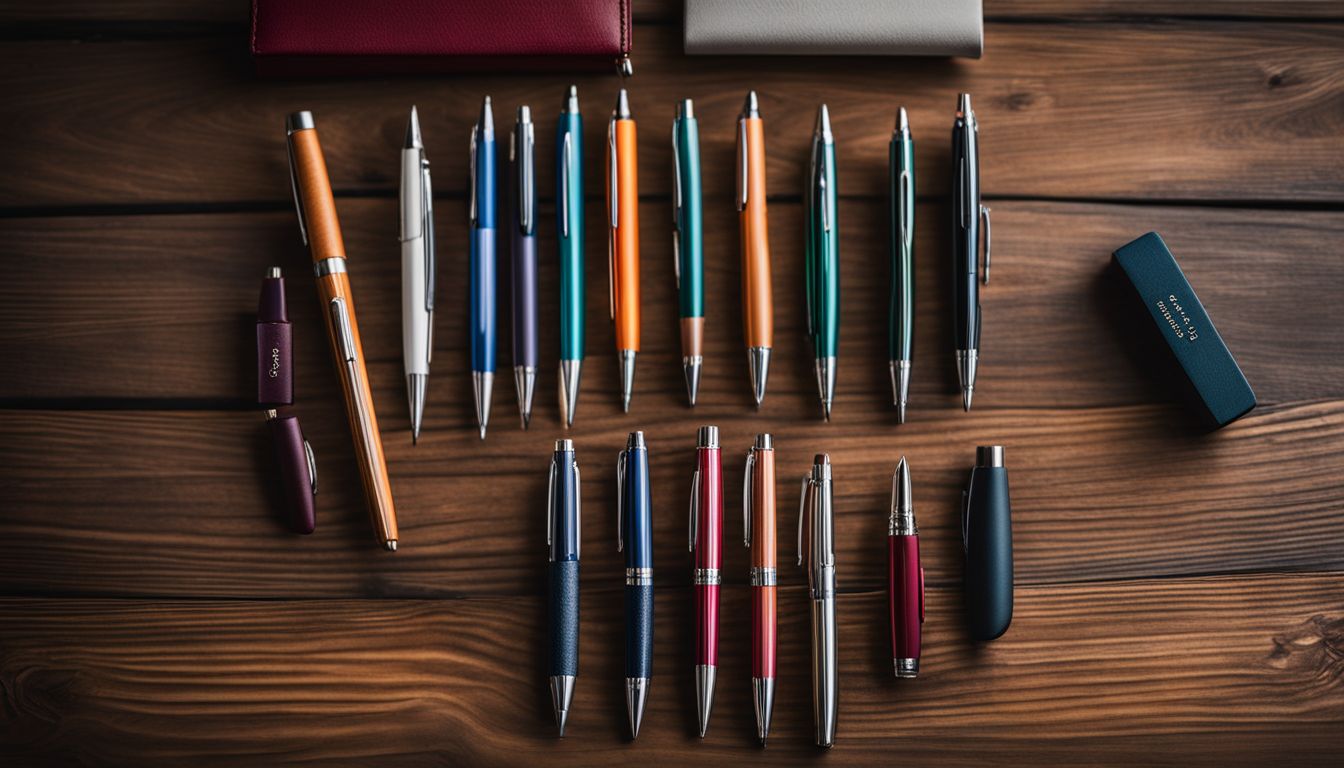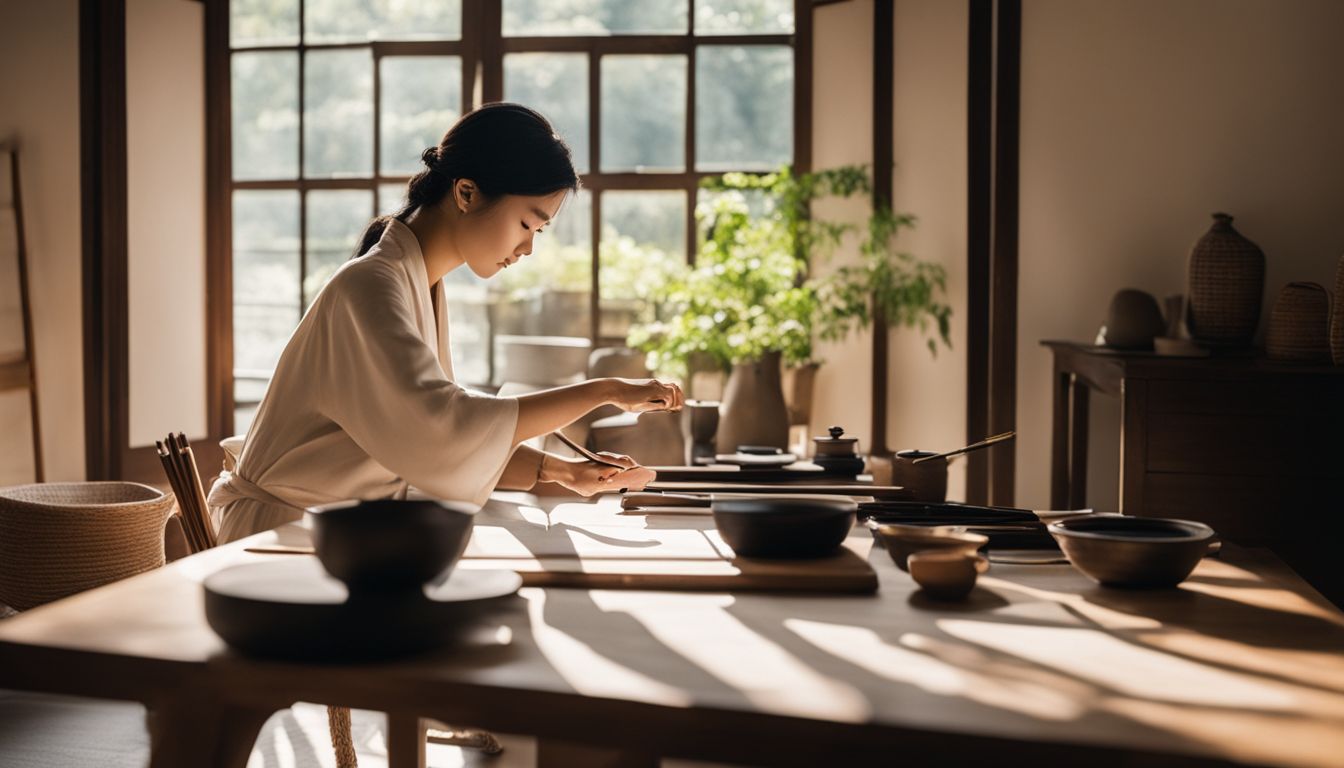Searching for the right ballpoint pen can feel like an endless quest, akin to finding a needle in a haystack. I understand the frustration of selecting one that promises not to give up on you in the middle of jotting down crucial thoughts.
That’s why I’ve dedicated time and effort into digging through various sources and rigorously testing different models to uncover what elevates a pen from merely transferring ink onto paper.
Through this exploration, we’ll delve into how aspects such as comfort grip, the quality of ink, and overall durability can transform your daily writing experience from mundane task to pure enjoyment — are you ready to embark on the journey toward your ideal writing companion?.
Key Takeaways
- Look for pens with quick-drying ink and ergonomic grips, especially if you’re left-handed to prevent smudges.
- Check the pen tip size and ink color; they affect your writing style and can serve different purposes like color-coding.
- Consider refillable ballpoint pens for an eco – friendly choice that also saves money in the long run.
- Pick a grip material and width that feel comfortable in your hand for long writing sessions without strain.
- Factor in the cost of the pen versus its value; affordable options can offer quality while pricier pens may provide additional features.
Understanding Different Types of Pens

When it comes to choosing the perfect ballpoint pen, it’s important to understand the different types of pens available. From ballpoint pens and rollerball pens to fountain pens and gel pens, each type offers unique features and benefits that cater to specific writing needs.
Understanding these differences will help you make an informed decision when selecting the right pen for your needs.
Ballpoint Pens
I love ballpoint pens for many reasons. They use oil-based ink, which means I can write on almost any surface without a problem. It dries quickly too, so there’s less chance of smudging my work.
Even with lots of writing to do, these pens don’t make my hand tired.
Some ballpoints come with a stylus tip as well. This is perfect for me because I switch between paper and my tablet often. I get the convenience of traditional writing and modern tech in one tool! Such multi-functionality makes ballpoint pens a smart choice for me.
Rollerball Pens
Rollerball pens are my go-to for a smooth writing session. They take the best parts of a ballpoint and mix it with the juicy ink you get from fountain pens. This means I can write for hours without my hand getting tired, and I don’t have to worry about constant pen care.
These pens come in lots of colors, making them perfect for people who love to add flair to their notes or drawings. Their liquid-based ink flows freely, so every line is consistent and sharp.
Plus, they dry quickly which is great because no one likes smudges on their work!
Fountain Pens
Fountain pens are like the luxury cars of writing instruments. They use liquid ink that flows smoothly onto paper, allowing for a range of handwriting styles from fine to bold. The flexibility fountain pens offer is unmatched; you can easily adjust pressure for different line widths and shading.
But they’re not just about good looks—they require some care too. Regular maintenance keeps the ink fresh and prevents it from drying up in the nib.
I enjoy picking out my fountain pen for a writing session. It feels special, and each one has its own personality. With these pens, I have to clean them now and then to keep things running smoothly.
It’s worth it though because that moment when the ink starts to flow on paper is pure magic. You get this feeling of connection between your thoughts and the words emerging on the page—it’s something ballpoints or gel pens just can’t match.
Gel Pens
Gel pens use gel/water-based ink, providing a smooth writing experience – effortless and vibrant. The range of opaque ink colors they offer is wide, making them versatile for various uses.
They are often interchangeable with rollerball pens in luxury pen sets.
Marker Pens
Marker pens are great for bold, water-based writing and drawing. They also work well for highlighting important information. These pens come with replaceable refills and a convenient push-button feature for easy use.
Marker pens are versatile tools perfect for both artistic endeavors and practical everyday tasks.
Factors to Consider When Choosing a Ballpoint Pen
When choosing a ballpoint pen, it’s important to consider factors such as the purpose of writing, preferred writing style, pen body materials, comfort and ergonomics, ink quality and consistency, and refillability for sustainability.
These elements will help you find the perfect pen that suits your needs and enhances your writing experience.
Purpose of Writing
I love pens, and I know there are so many options out there. With this guide, I want to help you choose the perfect ballpoint pen for your writing needs. From understanding different types of pens to considering factors like comfort, ink quality, and durability, we’ll explore it all together.
So let’s dive into the world of pens and pick the one that’s just right for you!
Preferred Writing Style
I aim for a conversational yet professional tone, providing actionable guidance with practical advice. I use authoritative and informative language while presenting data-driven and analytical insights to debunk myths and offer problem-solution formats.
My writing embraces sentence variety and comma liberalness for an engaging flow, mirroring natural speech. The style balances casual relatability with professionalism, incorporating ellipses and dashes for a casual effect.
Pen Body Materials
Ballpoint pens often have plastic pen bodies, which make them lightweight and budget-friendly. Rollerball pens can feature metal or plastic bodies, ensuring durability and ease of use.
Gel pens may come with either plastic or metal bodies, with higher-end models using materials such as brass or aluminum for a more premium feel. Stylus pens commonly incorporate a mix of metal and plastic in their pen bodies to balance functionality and affordability.
Fountain pens might include metal or resin bodies, while luxury options could boast materials like sterling silver or gold for added elegance.
Comfort and Ergonomics
Choosing a ballpoint pen that feels comfortable in my hand is crucial for long writing sessions. The grip should be ergonomic, allowing me to write without straining my fingers or experiencing discomfort.
Considering factors like the pen’s weight, shape, and material can help ensure it suits my writing style and minimizes hand fatigue.
I must also consider the width of the pen body; a wider pen may provide better support, while a slimmer design might suit smaller hands. Examining these ergonomic aspects can significantly enhance my overall writing experience and prevent hand cramps or fatigue during extended use.
Ink Quality and Consistency
When choosing a ballpoint pen, it’s essential to consider the ink quality and consistency. The oil-based ink of a ballpoint pen ensures smooth writing on various surfaces with minimal smudging or bleeding.
This type of ink is also long-lasting, making it suitable for everyday use.
Another important factor concerning ink quality is its consistency. A reliable ballpoint pen should consistently deliver a steady flow of ink without skipping or clumping, ensuring a seamless writing experience every time.
With these considerations in mind, selecting a pen with high-quality and consistent ink will significantly impact the overall satisfaction and performance of the writing utensil.
Refillability and Sustainability
Now that we’ve explored the importance of ink quality and consistency, let’s delve into refillability and sustainability. Opting for refillable pens not only saves money in the long run but also reduces environmental impact.
It’s a sustainable choice that aligns with eco-friendly practices, given that many refillable pens are crafted from recycled materials. By choosing refillable options, you’re making an environmentally conscious decision while enjoying the convenience of easily replenishing your favorite writing instrument.
Moreover, it’s worth noting that many pen manufacturers offer a wide range of colorful and high-quality ink refills for their refillable pens, providing both sustainability and versatility.
Unleashing Creativity: The Artistic Advantages of Ballpoint Pens
Ballpoint pens unleash creativity with their versatility and ability to create intricate designs. They offer unique artistic advantages due to the range of line widths and the ability to layer colors for depth.
The ink’s consistency allows smooth, controlled strokes on various surfaces, making it perfect for sketching, shading, and fine details in artwork. Ballpoint pens provide an affordable yet high-quality medium for artists, allowing them to explore different techniques and styles while maintaining precision and control over their artistic expression.
Ballpoint pens are not limited by paper – they can be used on canvas, wood, fabric, or even skin in the hands of skilled artists. Their durability makes them ideal tools for creating lasting masterpieces without fading or smudging over time.
Moreover, the availability of a wide range of ink colors gives artists endless possibilities when bringing their creative visions to life. These versatile writing utensils have revolutionized traditional art forms and continue to inspire new generations of artists.
Special Considerations for Left-Handed Writers
Left-handed writers need to prioritize pens with quick-drying ink and ergonomic grips for comfort while writing. High-quality ink is crucial to ensure smooth and consistent writing without interruptions, making quick-drying gel inks or oil-based ink the ideal choice for left-handed individuals.
Ink drying time and the type of pen used play a significant role in preventing smudging that left-handed writers often encounter.
Considering these special requirements can significantly enhance the writing experience for left-handed individuals, providing them with a more comfortable and efficient way to express their creativity on paper.
Now, let’s delve into exploring the grip and width for a more enjoyable writing experience.
Examining the Grip and Width for a Comfortable Writing Experience
I prefer pens with a comfortable grip and appropriate width for a pleasant writing experience. Here’s how to find the right fit:
- Consider the material of the pen’s grip – rubber, metal, or plastic – for a secure hold without slipping.
- The width of the pen should match your hand size to avoid strain during extended writing sessions.
Importance of Pen Tip Size and Ink Color
When considering the comfort of writing, it’s vital to acknowledge the significance of pen tip size and ink color. The choice of a pen tip size contributes to the legibility and style of your handwriting, while different ink colors can serve various purposes such as color-coding or adding visual appeal to your work.
Understanding how these factors impact your writing experience is crucial in choosing a pen that meets both functional and aesthetic needs.
Cost and Value of the Pen
Now that we’ve explored the importance of pen tip size and ink color for a comfortable writing experience, let’s delve into the cost and value of the pen. Ballpoint pens are widely available at affordable prices, with options ranging from under $5 to around $10.
These budget-friendly choices offer decent quality and reliability, making them suitable for everyday use without breaking the bank.
On the other hand, luxury pens like gel and rollerball pens can come with a higher price tag, often exceeding $20. While these pens may offer additional features and a more premium feel, it’s essential to consider whether their benefits align with your specific writing needs before investing in one.
Ultimately, finding the best pen isn’t about its cost but rather its ability to enhance your writing experience while providing excellent value for what you pay.
Recommendations for the Perfect Ballpoint Pen
When selecting the perfect ballpoint pen, consider these features:
- Purpose of Writing: Determine if it’s for everyday use, sketching, or detailed work.
- Preferred Style: Choose between slim or wider barrels for comfort during writing sessions.
- Pen Body Materials: Opt for lightweight plastic or durable metal according to personal preference.
- Comfort and Ergonomics: Select a pen with a grip design that fits comfortably in your hand.
- Ink Quality: Look for consistent ink flow and quick-drying properties to avoid smudging.
- Refillability: Consider pens with refill options to reduce environmental impact and cost over time.
Conclusion
To sum up, choosing the perfect ballpoint pen involves considering your writing purpose, preferred style, and comfort. Look for pens with quality ink, refill options, and sustainable materials to get the best value.
Furthermore, left-handed writers should pay attention to ink drying time and smudge resistance. Don’t forget to try out different grip styles and tip sizes for a comfortable writing experience.
Ultimately, finding the ideal ballpoint pen is about balancing functionality, creativity, and personal preference.
Discover the unique ways a ballpoint pen can enhance your artistic flair by visiting our in-depth guide on ballpoint pen art.
FAQs
1. What’s the difference between ballpoint pens and ink pens?
Ballpoint pens, like Bic or Parker Jotter, use oil-based ink that dries quickly on paper with no bleed. Ink pens—including rollerballs and fountain pens—have water-based inks which can flow more freely but might smudge or soak through your legal pads.
2. How do I pick a pen that won’t fall apart fast?
To make sure you get a pen that lasts, look for ones known for their durability—maybe something like the sturdy Lamy Safari. Check out what people say about it; good reviews often mean good performance!
3. Is one nib size the best choice for everyone?
Not at all! Nib sizes matter depending on what you need—for quick notes, a fine tip works well; if you’ve got bigger handwriting, try a broader nib. Test different sizes to see what feels right.
4. Can left-handed folks find comfortable pens too?
Absolutely! Southpaws sometimes struggle with ink smudging as they write from left to right—but certain biros are designed just for them. Quick-drying inks or certain felt tip pens might also do the trick.
5. Should my pen be just practical, or can it have some flair too?
Why not both? You can grab a reliable pen that writes smoothly and maybe even get it engraved for that personal touch—it’s easy to make your mark with style and function.




Leave a Reply
You must be logged in to post a comment.